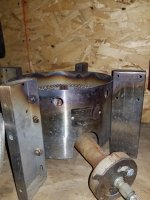Punk Brewster
Member
- Joined
- Feb 13, 2022
- Messages
- 8
- Reaction score
- 2
I'm looking to make the next jump to increase volume while limiting batch times but haven't found anyone who has anything to say, good or bad, about my idea to use a hellfire burner converted to natural gas to heat a brew kettle with electric elements running simultaneously until boil is achieved. Once it's boiling, I would cut the gas and go strictly electric.
The hellfire has a good heatshield so I'm not worried about melting wires... is there something that I'm missing that makes this a bad idea that no one talks about or is google AI hamstringing me by assuming and insisting that I meant to type electric vs gas?
The hellfire has a good heatshield so I'm not worried about melting wires... is there something that I'm missing that makes this a bad idea that no one talks about or is google AI hamstringing me by assuming and insisting that I meant to type electric vs gas?








